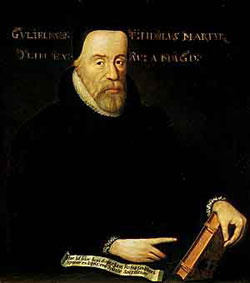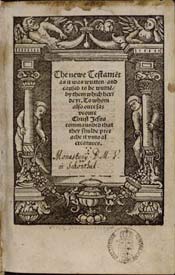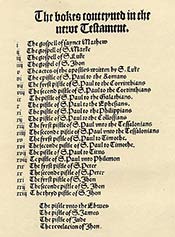The Gruber Rare Books Collection and Other Rare Books
English Bibles: Tyndale's Bible

William Tyndale 1494/95-1534
In the spring of 1524 Tyndale went to the Continent and spent about a year at Wittenberg. The first New Testament in English was printed at Worms, in February 1526 and copies reached England about a month later. Only two copies still exist, at Bristol and at St. Paul's Cathedral in London. See the reprint of 1862 below (Gruber 49). 80 pages of the New Testament had previously been printed in Cologne until the printer, Peter Quentel, was forbidden to proceed with the assignment. A facsimile of this edition, containing Matthew 1:1-22:12 was published in 1871 (see Gruber 101 below).
A prologue to this edition quotes Luther for a page and a half without mentioning the source of the quotation. The list of New Testament books in the Cologne fragments puts Hebrews, James, Jude, and Revelation at the end, without numbers as the first twenty-three had. This followed Luther's arrangement of the books. About half of the marginal notes are taken from Luther's New Testament. While Tyndale had Luther's translation and the Vulgate before him, his translation is based on the 3rd edition of the New Testament by Erasmus and is closer to the Greek than is Luther's.
Cuthbert Tonstall, Bishop of London, gathered and burned many copies of Tyndale's New Testament. The Bishop also purchased many copies on the Continent, and Tyndale used the profit from these sales to print more copies! Sir Thomas More also bitterly opposed Tyndale's translation: "[Tyndale's New Testament] was not worthy to be called Christ's testament, but either Tyndale's own testament or the testament of his master Antichrist." It was not so much the translation, but the translator that More objected to.
By 1530 Tyndale had translated the Pentateuch and completed Jonah in 1531. A translation of Joshua-2 Chronicles is probably also to be attributed to him, but was first published in Matthew's Bible of 1537. Tyndale revised his New Testament in 1534 and sharply criticized George Joye, who had published Tyndale's New Testament with corrections of his own. Nine tenths of the King James Version is really Tyndale's. In an appendix to this edition, Tyndale included Old Testament "Epistles," that were prescribed to be read in church. They are taken from the prophetic and poetic books, including Isaiah 53. Verse 2 reads: "He came vp as a sparow before him." "Sparow" may be a misprint for "spraye" (= tender twig or shoot).
During his last years Tyndale lived in Antwerp. Tyndale was kidnapped from there and imprisoned about six miles north of Brussels. Thomas Cromwell interceded for him, as did Henry VIII to a lesser extent, but Charles V let the law against heretics take its course with Tyndale. Charles was a nephew of Katharine of Aragon whom Henry VIII had divorced.
On October 6, 1536, Tyndale was put to death by strangling, and his body was burned. His last words: "Lord, open the king of England's eyes." Actually, a few months before Tyndale's death a version of the Bible in English, drawing heavily on Tyndale, was circulating in England with King Henry VIII's permission!
Some representative translations:
The serpent to Eve: "Tush, ye shall not die."
"The Lorde was with Joseph, and he was a luckie felowe." Gen 39:2
Pharaoh's "jolly captains" are drowned in the Red Sea Exod 15:2
"The LORD thy surgeon." Exod 15:26
A note on Exod 32:35, regarding the pestilence the befell the Israelites after worship of the golden calf, states: "The Pope's bull slayeth more than Aaron's calf."
The Lord's Prayer (1534): O oure father which arte in heven, halowed be thy name. Let thy kyngdome come. Thy wyll be fulfilled, as well in erth, as it ys in heven. Geve vs thisdaye oure dayly breede. And forgeve vs oure treaspases, even as we forgeve oure trespacers. And leade vs not into temptacion: but delyver vs from evell. For thyne is the kyngedome and the power, and the glorye for ever. Amen.
Gruber 49. Tyndale's New Testament of 1525 or 1526 in a reprint of 1862 at Bristol. Introduction by Francis Fry. Only 177 copies were printed. It shows the influence of Luther's 1522 German translation, and was at times called "Luther's Testament in English." The British Museum has the only fragment of the first issue know as "The Cologne Fragment."
Gruber 101. A facsimile of Tyndale’s New Testament, edited by Edward Arber and published in London in 1871. There are notes in this book, possibly by L. Franklin Gruber.
Gruber 116. Francis Fry, A Bibliographical Description of the Editions of the New Testament. Tyndale’s Version in English. London: Henry Sotheran, 1878.
Link to Tyndale Bible in the British Library
The Gruber Collection was assembled by L. Franklin Gruber, President of Chicago Lutheran Theological Seminary, Maywood, Illinois.
Annotation prepared by Ralph W Klein



